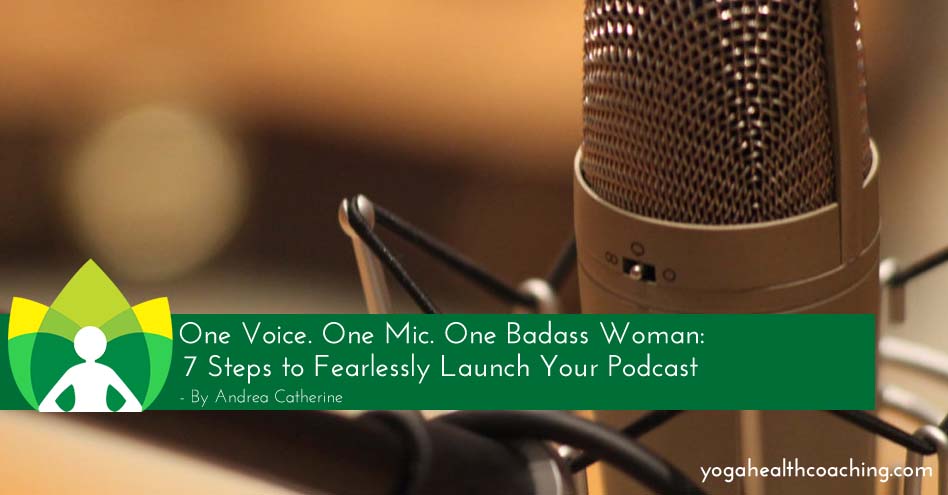
One Voice. One Mic. One Badass Woman: 7 Steps to Fearlessly Launch Your Podcast
Are you a podcast-listening junkie? Have you felt an urge to start a unique show to reach your health coaching clients?
If you answered “Yes,” read on — this blog is for you!
As a woman whose work is to guide other women on a path to wellness and self-acceptance, you’re likely already a pretty darn good listener. Perhaps you haven’t started a podcast because you think it requires having all the answers or doing all the talking. In my brief experience, and according to well-practiced podcasters, that’s just not true. In fact, there are at least three main ways to host a podcast:

- You show up as the expert — you lead your listeners into an educational or inspirational experience
- You interview experts — you talk to folks who can guide your listeners into an educational or inspirational experience. Your guests could also be ordinary people, sharing their stories.
- You collectively lead a conversation — you jam with a vocational counterpart (someone with a similar niche client, but with different offerings) to practice listening authentically, and receive the gift of being heard and affirmed. You come alive, your listeners get inspired, your mesh-network (and listener base) grows!
Clearly, number 3 is my preference!
Ayurveda can help, of course. To prepare for this blog post, I popped over to Ask Cate on the Yoga Healer podcast. Tune in to learn more about listening from your heart and whole body, trusting your own desire, and communicating effectively through podcasting, from the wisdoms of Ayurveda & Collaborative Intelligence.
Concrete Steps on How to Get Your Podcast Off The Ground
In order to provide you with a clear and doable process of how to create an established podcast, I turned to Yoga Health Coach, Brodie Welch. Her podcast, A Healthy Curiosity, is 50 episodes strong and inspires me every time I listen. The show, “explores what it takes to be well in a busy world, using self-care tips from Chinese Medicine.”
Step 1: Identify & Believe In Your Mission.
-
Ask Yourself Some Questions Before You Hit Record
Brodie suggests you start with asking yourself these questions:
- What are you setting out to do?
- How do you want people to see (err…hear) you?
- What is the purpose of your podcast, so to speak?
- What role will you play?
“Are you the expert? And inspiration unto yourself? A supportive cheerleader and champion? [Or] crusading world-changing activist?,” asks Brodie. “Who says you have to talk to anyone at all? You could do a solo show and give out tips every week.”
Some common reasons for hosting a podcast include:
- Educating your target market
- Providing inspiration to your community of listeners
- Growing your business
- Expanding your funnel or audience by boosting your know-like-trust factor
Whether you decide to show up as the expert, interviewer or collaborator, your approach and your guest selection “should give you an opportunity to shine in the way you want to highlight,” says Brodie.
Maybe you’re becoming a little more clear on your podcasting vision, yet you still might require a bit of encouragement or affirmation.
-
Believe In Yourself.
Identifying your mission is really naming what you’re good at. If you’ve gotten clear on your mission, you have something to say. And guess what?
Your voice is needed! According to Forbes: An estimated 70 percent of the most popular podcasts are hosted by men, yet close to half of podcast listeners are women, Edison Research.
“Women have half the voices on the planet, yet far less than half of the airtime, says Brodie. “Because podcasting has a relatively low barrier to entry, it’s an incredibly democratic form of media, a way of sharing your message and your story, and your medicine with anyone who wants to hear. So whether you’re male or female or somewhere in between, the world needs your gifts.”
If you’re reading this, you’re curious about sharing your message more widely through podcasting. Look over some of your testimonials, remember you have something to share that is life-changing. And go for it! In other words-Believe in yourself and add several exclamation points!!!!!
Step 2: Set The Scene.
-
Create Your Space
“Choosing a microphone is not nearly as important as designing your podcasting space,” suggests Brodie. She reminds me to avoid an echo chamber, and opt for a cozy space with a door, preventing interruptions from housemates or pets. Opt for soft features — carpet, pillows, cushions on furniture to create a comfortable space, and to enhance your ability to listen and be present while recording.
Did you know that Cate Stillman always records the Yogahealer Real LIfe show standing up? She prefers feeling her feet on the ground. When she stands, she is able then to listen from her heart downward, and engage in full-body listening.
-
Schedule With Ease
You don’t have to record your podcasts live or even at the same exact time weekly or monthly, unless that works for your schedule and for you to feel more at ease, and present in your own body. Most important is that your listeners can expect a reliable release date of your show. Set a regular recording interval that allows you ample to edit and publish by your release date.
-
Bank Your Show
Many podcasters record 5-10 episodes before releasing their first one on a main media platform. This way they have a head start. Having a few episodes ready to go, will give you time to record future podcasts without feeling rushed. Banking your show recordings will also buffer your sick days, planned vacations and emergencies that require you to delay a recording. I was relieved to learn this was a strategy many podcasters I admire have utilized, especially since I am still working to get my podcasts on itunes and other outlets. When I do, I will benefit as if I had strategized this way from the get go!
Step 3: Speak To Your Listeners
-
Niche Market

Now that you know how you want to show up and set up, it’s crucial, just like when you teach your courses, that you speak to your ideal client, or in this case, your ideal listener. Not every listener will become a client:
“Having a podcast allows me to … help people who might not ever become a client. It provides a service branch to my business, which feels amazing. I hear stories about people who were listening to my show and had a friend walk in, hear something useful and say ‘I’m going to try that!’ So there’s a ripple effect where I’m able to reach people in a very intimate way (between their ears!).” — Brodie Welch
I love the advice to to write a blog post or newsletter to a specific ideal client, as if she’s the only one listening. When we do this, we know at least one person is listening. When podcasting, speak to her as well. What would she most benefit from hearing? As Cate says, when one person talks, we hear the echo of 1000 voices. So, when one person listens, 1000 are waiting to catch the echo in the wind. Whatever you have to say will be meaningful to many more than the one person you are targeting.
-
Consider Constitutions
Remember that all of your podcast followers are influenced by their Ayurvedic constitution to focus, process or space out when listening. You may also want to consider what your guests will benefit from feeling, doing, seeing, or even tasting & smelling (depending on the topic of your show).
Cate suggests catering to the audio, visual, kinesthetic needs of your listeners. You’ll benefit from incorporating visual and movement cues to keep your audience engaged.
We talk about the various ways listeners listen and how perk their ears in our recent podcast.
Step 4: Collaborate With Your Guests
Who do you listen to? My guess is you don’t only listen to other Yoga Health Coaches. You have other interests, hobbies, curiosities, appeal to your niche clientele, and also those who might be lurking around the fringes.
-
Vet Your Guest
You might start your guest-vetting process by considering where your expertise and that of a guest overlap, or where their expertise fills a gap on a topic you want to address for your listeners, but need support in order to do so.
Brodie asks “them what they are most passionate about sharing these days. Or what [they wished] the world knew about their topic.”
Consider how your guest could express their passion or expertise to the greatest benefit your listener.
Of course, the more what your guest is passionate about sharing aligns with what your listener wants to hear, the better!
-
Listen To Speak
When it’s clear it’s a good fit, you can either a) send the interviewee questions in advance so both people are working from the same script, or b) suggest the topic of discussion in advance, then allow the conversation to flow organically while you record.
Your guest may have a preference. In my short time podcasting, I have found that some guests strongly prefer to have time to ponder questions in advance, and others are eager for an on the fly chat. My guess is that your knowledge of Ayurvedic constitutions tells you why that is.
Whether or not your guest has reviewed specific questions, having a list you can refer to while you record is quite helpful “in case of awkward silences,” says Brodie. “But for the most part I like to let it flow.”
Cate suggests listening for what’s sparking your desire to learn more about what your guest is saying and how to trust the flow of a conversation.
-
Call To Action
Now what? After listening to your show, is there something your listener can do to implement your educational insight? Either you or your guest can offer a suggested action step. Remember kaizen if you’re encouraging listeners to try on a new habit.
“I want to make sure everyone can take away at least one practical tip to make it worth their while to tune in,” says Brodie.
A tip doesn’t have to be something hard or even new. It could be inviting your guests to remind themselves of their own intrinsic value, to sit in the sun and breath in the mantra, “I have everything I need.”
Step 5: Create Connection with Content Marketing
Podcasting is content marketing. But just because someone listens to your podcast and loves it, doesn’t mean they’ll walk into your next class as your shining ideal client. You have to give them the opportunity to do so.
-
Record Commercials
You might be wondering…Do I have to publicize myself in commercials on my show? The short answer is no. You could sell ads that bring your listeners to other people’s products, and they in turn may market your show to more listeners. But, Brodie reminded me of the harsh reality of podcasting,
“Somebody’s got to pay the bills. Podcasting isn’t free, and people understand that shows have sponsors. When you are your own show’s sponsor, you are talking to people who are already interested in the stuff you like to talk about, [which] presumably relates to your offerings. Having a dedicated space where you tell them how they can connect with you further provides them a service: you are helping them to take the next step if that’s what they’re ready to do. Rather than thinking of it as a commercial, I like to think of it as a time out of the conversation to explicitly invite the listener to connect with me.”
-
Utilize Testimonials
One strategy I used to help get me over my own resistance hump to creating my own commercial was incorporating client testimonials. This way I could ground myself in the outcomes of my work. I felt validated inviting people to have a conversation with me about the work I did with them. Testimonials aren’t necessary (listen to Cate & Brodie’s shows for examples), but they helped me create my first commercials.
Step 6: Edit for Relevance
This is my least favorite step. Up until this point I am in my zone of genius. Once I say good-bye to my guest and listeners and the recording is complete, I want to be complete, too. I do, however, recognize there is much value is not just posting the recording right away.
-
It’s Worth It
In Brodie’s experience, “you don’t want to waste the listeners time listening to tangents that are relevant to the topic. While you don’t have to leave out every “um,” “uh” and “like,” you will have guests who use filler words so much that it’s almost painful to listen to.”
Remember, you’ve worked hard to get a topic, guest and conversation together that will meet your listener where she is and wake her up to something new or her own inner intelligence. You don’t then want her to “get annoyed and tune out.”
-
We’re Not Perfect

Having the opportunity to edit allows you to speak more freely and naturally. As it could be you who says something you don’t want on your show!
I once was so excited to tell a guest about an experience that it was all I was thinking about while she talked. I caught myself and started to pay attention. When she was done, I said, “Yeah, that reminds me of this coach who I really admire…” and I couldn’t remember who it was or what I wanted to say. I stopped the recording, figured out where to start again, and when back to smooth out the transition after our time was complete.
Brodie, too, says “things that are a little too candid: for example, something from my personal world that may not be totally mine to share if it involves a friend or family member.”
If anything is said that you think might offend your listeners, the ones you want to keep listening, the ones you hope to help or become clients, remove that, too. Thankfully, I have not had to do this yet.
Brodie has removed “comments and even not used entire interviews that seem sexist, not inclusive of LGBTQ people, or otherwise not in line with the values that I hold dear.”
-
Keep Track While Recording
Brodie suggests that while listening, you note the minutes and seconds of what you want to remove, to shorten your editing time.
Of course, staying on track and considering what you say before you say it will limit the amount of time you spend in front of your editing software after the show.
If you don’t want to do the editing yourself, hire a techy Virtual Assistant.
Step 7: Make Your Podcast Accessible
Are you asking what I’ve been asking?, “How the F*** do I get on itunes?!”
-
Establish Your RSS Feed
“If you want all the places where people might get their podcasts from to have regular access to new show that you upload, you need to have your feed hosted somewhere. I use Libsyn, but there are plenty of podcast hosting companies dedicated to maintaining your RSS feed,” says Brodie, and all successful podcasts everywhere.
If you choose Libsyn, they have some tutorials that may be helpful to you or your VA for getting started.
-
Follow Instructions
Once you have a podcast host it’s time to upload, not just your new episode, but also cover art, and show notes. Your hosting site (ex: Libsyn) will post it to iTunes, or other media outlets like Google Play, Sound Cloud, etc .
Do note that “iTunes is extremely picky about their specifications for cover art. So you definitely want to look that up before spending any time on it,” says Brodie, and I agree! Take your time, and get it right, or you won’t get it at all.
-
Celebrate!
Once your podcast is live and free to the masses, it’s time to celebrate YHC style. Get a jar of kombucha, call your girlfriends and have a brag circle. Share your win for this great accomplishment. Have your phone at the ready, I may be calling you soon!
“With a mixture of compassion, strategy, and healing expertise, I share my message with the world: that self-care isn’t selfish, that when we change the way we breathe, move, handle stress, and nourish ourselves, we dramatically change how we feel.” — Brodie Welch



